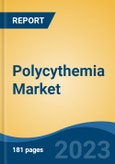Speak directly to the analyst to clarify any post sales queries you may have.
10% Free customizationThis report comes with 10% free customization, enabling you to add data that meets your specific business needs.
Key Market Drivers
Increasing Disease Awareness and Diagnosis
Improved awareness and diagnostic capabilities are key drivers propelling the global polycythemia market. Historically underdiagnosed due to non-specific symptoms, polycythemia is now more frequently detected owing to growing clinical vigilance and the availability of routine hematological testing. Healthcare professionals are becoming increasingly adept at identifying early signs such as elevated hematocrit levels and persistent fatigue, leading to earlier interventions and improved prognosis. Public health campaigns, scientific publications, and advocacy by patient organizations have also played a vital role in highlighting the disease. With improved access to diagnostic tools like complete blood count (CBC) and genetic screening, more cases are now being recognized and treated promptly. As reported in a 2020 MDPI study, global annual incidence rates highlight a higher prevalence of polycythemia vera (PV) and essential thrombocythemia (ET), underscoring the need for early diagnosis and targeted care.Key Market Challenges
Limited Disease Awareness and Diagnosis
Despite progress, limited disease recognition remains a significant barrier to market growth. Due to its rarity and overlapping symptoms with other conditions, polycythemia often goes undetected or misdiagnosed. Many healthcare professionals, particularly in primary care settings, may lack familiarity with the disease's clinical presentation or its diagnostic criteria. As a result, patients can experience delays in receiving appropriate care, which increases their risk of developing severe complications.The general population also remains largely unaware of polycythemia, leading to a low rate of self-referral or health-seeking behavior for symptoms such as headaches or unexplained fatigue. Addressing this gap requires coordinated efforts from medical societies, pharmaceutical companies, and advocacy groups to enhance education and screening practices. Expanding outreach and training programs is essential to improving early detection and patient outcomes.
Key Market Trends
Advancements in Targeted Therapies
Targeted therapy development is a key trend reshaping the global polycythemia market. Traditional treatments like therapeutic phlebotomy, while effective at symptom management, do not address the molecular basis of the disease. Innovations in drug development now focus on agents that inhibit specific pathways and genetic mutations, such as JAK2 V617F, which are commonly implicated in polycythemia vera.These therapies offer the promise of durable disease control with fewer side effects and a reduced need for invasive procedures. Pharmaceutical companies are investing heavily in R&D to bring to market precision medicines that not only manage symptoms but modify disease progression. This trend aligns with the broader movement toward personalized healthcare, offering tailored interventions based on a patient’s unique genetic and molecular profile. The emergence of these therapies marks a critical step forward in improving long-term outcomes and elevating the standard of care for polycythemia patients.
Key Players Profiled in this Polycythemia Market Report
- Novartis AG
- Incyte Corporation
- Bristol-Myers Squibb Company
- Eli Lilly and Company
- PharmaEssentia Corporation
- Dr. Reddy's Laboratories Ltd.
- LC Laboratories
- Par Pharmaceutical
- Taj Life Sciences Pvt. Ltd
- GSK plc
Report Scope:
In this report, the Global Polycythemia Market has been segmented into the following categories, in addition to the industry trends which have also been detailed below:Polycythemia Market, by Type:
- Primary Polycythemia
- Secondary Polycythemia
- Pseudopolycythemia
Polycythemia Market, by Treatment:
- Phlebotomy
- Aspirin
- Myelosuppressive Agents
- Selective Serotonin Reuptake Inhibitor
- Others
Polycythemia Market, by Route of Administration:
- Oral
- Intravenous
- Intramuscular
Polycythemia Market, by Distribution Channel:
- Hospital Pharmacies
- Retail Pharmacies
- Online Pharmacies
Polycythemia Market, by Region:
- North America
- United States
- Canada
- Mexico
- Europe
- France
- United Kingdom
- Italy
- Germany
- Spain
- Asia-Pacific
- China
- India
- Japan
- Australia
- South Korea
- South America
- Brazil
- Argentina
- Colombia
- Middle East & Africa
- South Africa
- Saudi Arabia
- UAE
Competitive Landscape
Company Profiles: Detailed analysis of the major companies present in the Global Polycythemia Market.Available Customizations:
With the given market data, the publisher offers customizations according to a company's specific needs. The following customization options are available for the report.Company Information
- Detailed analysis and profiling of additional market players (up to five).
This product will be delivered within 1-3 business days.
Table of Contents
Companies Mentioned
The leading companies profiled in this Polycythemia market report include:- Novartis AG
- Incyte Corporation
- Bristol-Myers Squibb Company
- Eli Lilly and Company
- PharmaEssentia Corporation
- Dr.Reddy's Laboratories Ltd.
- LC Laboratories
- Par Pharmaceutical
- Taj Life Sciences Pvt. Ltd
- GSK plc
Table Information
| Report Attribute | Details |
|---|---|
| No. of Pages | 185 |
| Published | May 2025 |
| Forecast Period | 2024 - 2030 |
| Estimated Market Value ( USD | $ 1.89 Billion |
| Forecasted Market Value ( USD | $ 2.64 Billion |
| Compound Annual Growth Rate | 5.7% |
| Regions Covered | Global |
| No. of Companies Mentioned | 11 |









